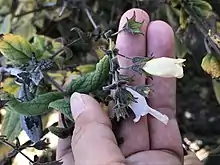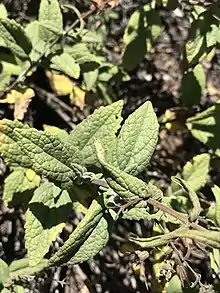| Lepechinia ganderi | |
|---|---|
 | |
| Scientific classification | |
| Kingdom: | Plantae |
| Clade: | Tracheophytes |
| Clade: | Angiosperms |
| Clade: | Eudicots |
| Clade: | Asterids |
| Order: | Lamiales |
| Family: | Lamiaceae |
| Genus: | Lepechinia |
| Species: | L. ganderi |
| Binomial name | |
| Lepechinia ganderi | |
Lepechinia ganderi is a rare species of perennial shrub in the mint family known by the common name San Diego pitcher sage or Gander's pitcher sage. An aromatic plant with white to lavender flowers, this species is only known from southern San Diego County in California and a small portion of Baja California, occurring on chaparral or coastal sage scrub in metavolcanic soils.[2] Because of its limited range, it is under threat from growing urbanization and increased fire frequency.[1][3]
Description

Lepechinia ganderi is a short, aromatic shrub with slender branches coated in rough hairs and resin glands. The leaves are lance-shaped (lanceolate) and may have toothed (serrate) edges. The raceme inflorescence bears flowers on pedicels that are 1 to 2 cm long. Each flower has a base of long, pointed sepals below a white to light lavender tubular corolla. The flower is lipped at the mouth. The small, dark, hairless fruit develops attached to the sepals once the corolla falls.[4]
The flowers are pollinated by bees and hummingbirds.[3]
Taxonomy
The type specimen of this species was collected on Otay Mountain. Plants of this species have a chromosome count of n = 16.[5] Phylogenetic analyses place this species in a well-supported clade with Lepechinia calycinia, and within a larger clade that mostly consists of Mexican and Central American taxa.[6]
Distribution and habitat
This species is a near-endemic to southern San Diego County, California and the neighboring border region of Baja California. It is known from around 20 occurrences in the United States, many on federal land.[7] The Mexican populations are not well studied.[3] It is distributed throughout the coastal Peninsular Range foothills and mountains in this area, including Otay Mountain and the Jamul Mountains.[2][8]
Plants of this species are typically found growing on rocky, metavolcanic, gabbroic substrates, often in habitats ranging from coastal sage scrub and chaparral to closed-cone coniferous forest, such as Tecate cypress groves,[9] and grasslands,[2] at elevations from 500 to 1060 meters.[5]
See also
- California chaparral and woodlands
- Clinopodium chandleri – Another rare plant species in the mint family that occupies a similar nearby habitat
- Lepechinia cardiophylla – Similar, but with broader calyx lobes and a mildly cordate leaf base
References
- 1 2 "Lepechinia ganderi". NatureServe Explorer. Arlington, Virginia: NatureServe. 2022. Retrieved 30 January 2022.
- 1 2 3 "Lepechinia ganderi". rareplants.cnps.org. California Native Plant Society, Rare Plant Program. 2022. Retrieved 30 January 2022 – via Inventory of Rare and Endangered Plants of California (online edition, v9-01 1.0).
- 1 2 3 Davitt, Joe (28 October 2016). "Saving San Diego's Rare Mints". San Diego Zoo Wildlife Alliance. Retrieved 30 January 2022.
- ↑ Averett, Deborah Engle (2012). "Lepechinia ganderi". Jepson eFlora. Jepson Flora Project. Retrieved 30 January 2022.
- 1 2 Beauchamp, R. Mitchel. A Flora of San Diego County, California. Sweetwater River Press. p. 176.
- ↑ Drew, Bryan; Cacho, N. Ivalu; Sytsma, Kenneth (2014-08-28). "The transfer of two rare monotypic genera, Neoeplingia and Chaunostoma, to Lepechinia (Lamiaceae), and notes on their conservation". Taxon. 63 (4): 831–842. doi:10.12705/634.6.
- ↑ Tracey, Jeff; McEachern, Kathryn; Greer, Keith (January 2011). "San Diego Rare Plant Monitoring Plan" (PDF). San Diego Management & Monitoring Program (Fiscal Year 2011 ed.). Retrieved 30 January 2022.
- ↑ Rebman, J. P.; Gibson, J.; Rich, K. (2016). "Annotated checklist of the vascular plants of Baja California, Mexico" (PDF). San Diego Society of Natural History. 45: 181.
- ↑ Rhind, Peter Martin (2010). "Plant Formations in the Californian BioProvince" (PDF). terrestrial-biozones.net. Retrieved 30 January 2022.
External links
